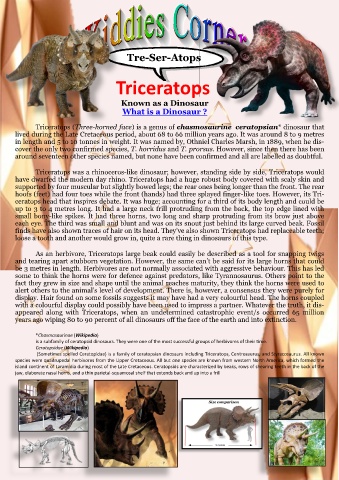Page 141 - Prehistoric Animals
P. 141
Tre-Ser-Atops
Triceratops
What is a Dinosaur ?
Known as a Dinosaur
Triceratops (Three-horned face) is a genus of chasmosaurine ceratopsian* dinosaur that
lived during the Late Cretaceous period, about 68 to 66 million years ago. It was around 8 to 9 metres
in length and 5 to 10 tonnes in weight. It was named by, Othniel Charles Marsh, in 1889, when he dis-
cover the only two confirmed species, T. horridus and T. prorsus. However, since then there has been
around seventeen other species named, but none have been confirmed and all are labelled as doubtful.
Triceratops was a rhinoceros-like dinosaur; however, standing side by side, Triceratops would
have dwarfed the modern day rhino. Triceratops had a huge robust body covered with scaly skin and
supported by four muscular but slightly bowed legs; the rear ones being longer than the front. The rear
hoofs (feet) had four toes while the front (hands) had three splayed finger-like toes. However, its Tri-
ceratops head that inspires debate. It was huge; accounting for a third of its body length and could be
up to 3 to 4 metres long. It had a large neck frill protruding from the back, the top edge lined with
small bony-like spikes. It had three horns, two long and sharp protruding from its brow just above
each eye. The third was small and blunt and was on its snout just behind its large curved beak. Fossil
finds have also shown traces of hair on its head. They’ve also shown Triceratops had replaceable teeth;
loose a tooth and another would grow in, quite a rare thing in dinosaurs of this type.
As an herbivore, Triceratops large beak could easily be described as a tool for snapping twigs
and tearing apart stubborn vegetation. However, the same can’t be said for its large horns that could
be 3 metres in length. Herbivores are not normally associated with aggressive behaviour. This has led
some to think the horns were for defence against predators, like Tyrannosaurus. Others point to the
fact they grew in size and shape until the animal reaches maturity, they think the horns were used to
alert others to the animal’s level of development. There is, however, a consensus they were purely for
display. Hair found on some fossils suggests it may have had a very colourful head. The horns coupled
with a colourful display could possibly have been used to impress a partner. Whatever the truth, it dis-
appeared along with Triceratops, when an undetermined catastrophic event/s occurred 65 million
years ago wiping 80 to 90 percent of all dinosaurs off the face of the earth and into extinction.
*Chasmosaurinae (Wikipedia)
is a subfamily of ceratopsid dinosaurs. They were one of the most successful groups of herbivores of their time.
Ceratopsidae (Wikipedia)
(Sometimes spelled Ceratopidae) is a family of ceratopsian dinosaurs including Triceratops, Centrosaurus, and Styracosaurus. All known
species were quadrupedal herbivores from the Upper Cretaceous. All but one species are known from western North America, which formed the
island continent of Laramidia during most of the Late Cretaceous. Ceratopsids are characterized by beaks, rows of shearing teeth in the back of the
jaw, elaborate nasal horns, and a thin parietal-squamosal shelf that extends back and up into a frill

